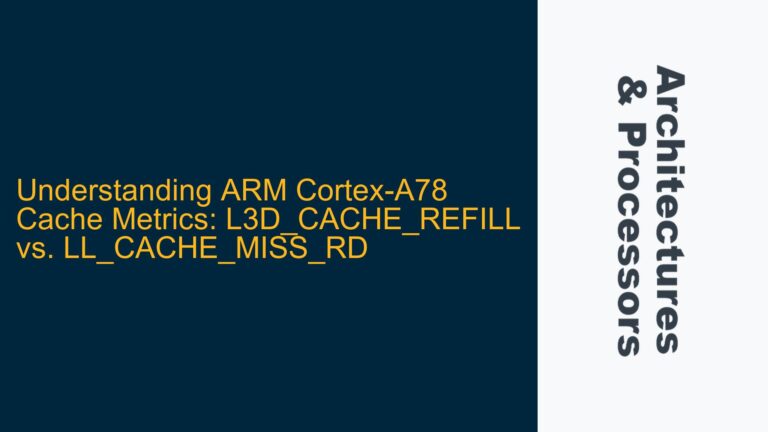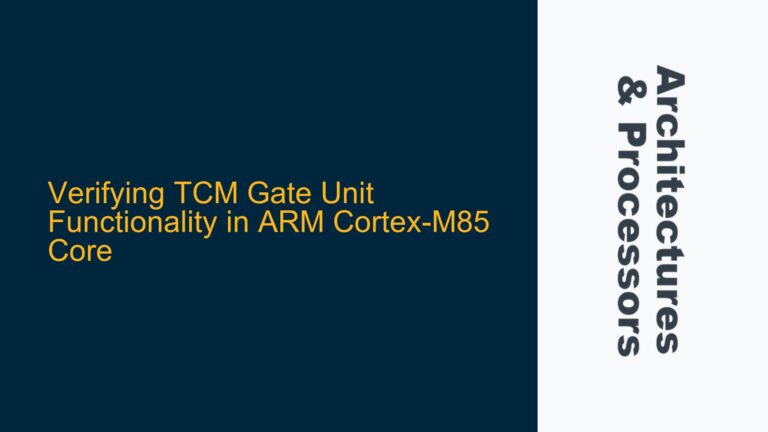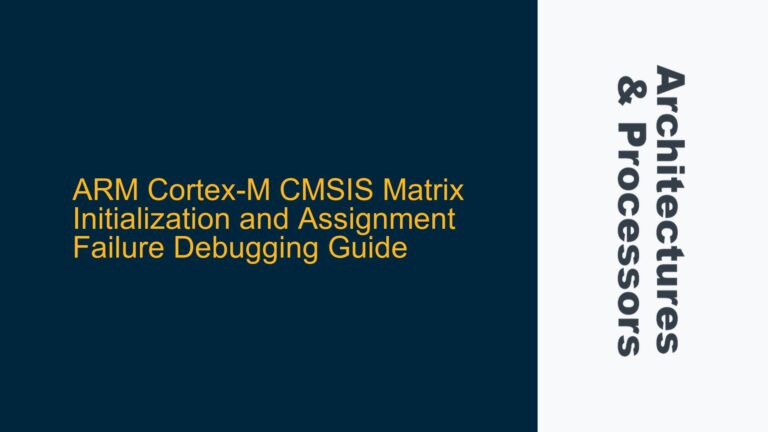ARM Cortex-A53 NEON Performance Bottlenecks in Loop Unrolling
The core issue revolves around optimizing a loop that calculates the magnitude of a complex float vector using ARM Cortex-A53’s NEON SIMD (Single Instruction, Multiple Data) capabilities. The original code processes four complex float elements per iteration, leveraging NEON intrinsics for vectorized operations such as loading, multiplication, accumulation, and square root. The goal is to improve performance by unrolling the loop and reordering load, calculation, and store operations to maximize instruction-level parallelism and minimize pipeline stalls.
The Cortex-A53 is a 64-bit ARMv8-A processor with a dual-issue, in-order pipeline. While it supports advanced SIMD (NEON) operations, its in-order nature makes it particularly sensitive to instruction scheduling and memory access patterns. The NEON unit can process up to four 32-bit floating-point operations in parallel, but its performance is heavily dependent on how well the compiler or programmer can hide latency and avoid resource contention.
The original implementation processes four complex float elements per iteration, but the unrolled version processes sixteen elements per iteration. Despite the unrolling, the performance improvement is only 15%, which suggests that the code is still not fully utilizing the Cortex-A53’s capabilities. The key bottlenecks are likely related to instruction scheduling, memory access patterns, and NEON pipeline utilization.
Instruction Scheduling and Memory Access Patterns in NEON Code
The primary cause of suboptimal performance in the unrolled loop is inefficient instruction scheduling and memory access patterns. The Cortex-A53’s in-order pipeline requires careful sequencing of instructions to avoid stalls. In the unrolled version, the sequence of operations for each set of four complex float elements is as follows:
- Load two NEON registers (real and imaginary parts) using
vld2q_f32. - Multiply and accumulate the squared magnitudes using
vmulq_f32andvmlaq_f32. - Compute the square root using
vsqrtq_f32. - Store the result using
vst1q_f32.
While this sequence is logically correct, it does not fully exploit the Cortex-A53’s dual-issue capability. The NEON unit can execute two instructions per cycle, but only if they are independent and do not contend for the same resources. In the current implementation, there are several dependencies between instructions that prevent optimal dual-issue execution. For example, the result of the vld2q_f32 load is immediately used in the subsequent vmulq_f32 and vmlaq_f32 operations, creating a chain of dependencies that limits parallelism.
Additionally, the memory access pattern may not be optimal. The vld2q_f32 instruction loads 128 bits of data (four 32-bit floats) from memory, but the Cortex-A53’s L1 data cache has a 64-byte line size. If the data is not aligned or if there are cache misses, the memory subsystem may become a bottleneck. The unrolled version processes sixteen elements per iteration, which increases the working set size and may exacerbate cache contention.
Another potential issue is the use of vsqrtq_f32, which is a relatively expensive operation in terms of latency and throughput. The Cortex-A53’s NEON unit has limited resources for floating-point operations, and the square root operation may stall the pipeline if not properly interleaved with other instructions.
Optimizing NEON Code for Cortex-A53: Instruction Reordering and Cache Utilization
To address the performance bottlenecks, the following optimizations can be applied:
Instruction Reordering for Dual-Issue Execution
The key to maximizing performance on the Cortex-A53 is to reorder instructions to minimize dependencies and enable dual-issue execution. The following steps can be taken:
- Interleave load and store operations with arithmetic operations to hide latency. For example, after loading the first set of data, start processing it while loading the next set.
- Use multiple accumulators to break dependency chains. Instead of using a single accumulator (
Res0), use four accumulators (Res0,Res1,Res2,Res3) to allow independent computation of multiple elements in parallel. - Reorder the sequence of operations to maximize parallelism. For example, compute the squared magnitudes for multiple elements before computing the square roots.
Here is an example of how the code can be restructured:
void Abs(ComplexFloat *pIn, float *pOut, uint32_t N) {
float *pDst = (float*)pOut;
float32x4_t Res0, Res1, Res2, Res3;
float32x4x2_t Vec0, Vec1, Vec2, Vec3;
ComplexFloat *pSrc = pIn;
for (int n = 0; n < N >> 4; n++) {
// Load first set of data
Vec0 = vld2q_f32((float*)pSrc);
pSrc += 4;
// Start processing first set while loading the next
Res0 = vmulq_f32(Vec0.val[0], Vec0.val[0]);
Res0 = vmlaq_f32(Res0, Vec0.val[1], Vec0.val[1]);
Vec1 = vld2q_f32((float*)pSrc);
pSrc += 4;
// Process second set while loading the third
Res1 = vmulq_f32(Vec1.val[0], Vec1.val[0]);
Res1 = vmlaq_f32(Res1, Vec1.val[1], Vec1.val[1]);
Vec2 = vld2q_f32((float*)pSrc);
pSrc += 4;
// Process third set while loading the fourth
Res2 = vmulq_f32(Vec2.val[0], Vec2.val[0]);
Res2 = vmlaq_f32(Res2, Vec2.val[1], Vec2.val[1]);
Vec3 = vld2q_f32((float*)pSrc);
pSrc += 4;
// Process fourth set
Res3 = vmulq_f32(Vec3.val[0], Vec3.val[0]);
Res3 = vmlaq_f32(Res3, Vec3.val[1], Vec3.val[1]);
// Compute square roots in parallel
Res0 = vsqrtq_f32(Res0);
Res1 = vsqrtq_f32(Res1);
Res2 = vsqrtq_f32(Res2);
Res3 = vsqrtq_f32(Res3);
// Store results
vst1q_f32((float*)pDst, Res0);
pDst += 4;
vst1q_f32((float*)pDst, Res1);
pDst += 4;
vst1q_f32((float*)pDst, Res2);
pDst += 4;
vst1q_f32((float*)pDst, Res3);
pDst += 4;
}
}
Cache Utilization and Data Alignment
To optimize cache utilization, ensure that the input and output arrays are aligned to 64-byte boundaries. This reduces the likelihood of cache line splits and improves memory access efficiency. Use __attribute__((aligned(64))) to enforce alignment:
ComplexFloat *pIn __attribute__((aligned(64)));
float *pOut __attribute__((aligned(64)));
Additionally, consider prefetching data into the cache to hide memory latency. The __builtin_prefetch intrinsic can be used to prefetch the next set of data while processing the current set:
__builtin_prefetch(pSrc + 16, 0, 0); // Prefetch next 16 elements
Reducing Square Root Latency
The vsqrtq_f32 operation is relatively expensive, so it is important to minimize its impact on the pipeline. One approach is to compute the square roots in parallel after all the squared magnitudes have been calculated. This allows the NEON unit to process multiple square roots concurrently, reducing overall latency.
Compiler Flags and Loop Unrolling
Experiment with different compiler flags to achieve the best performance. For example, using -O3 -mcpu=cortex-a53 -ffast-math can enable additional optimizations, such as aggressive loop unrolling and floating-point optimizations. However, be cautious with -ffast-math, as it may affect numerical accuracy.
Performance Measurement and Profiling
Finally, use performance measurement tools such as ARM Streamline or perf to profile the optimized code and identify any remaining bottlenecks. Pay attention to metrics such as CPI (Cycles Per Instruction), cache misses, and NEON utilization to guide further optimizations.
By carefully reordering instructions, optimizing cache utilization, and reducing the impact of expensive operations, the performance of the NEON code on the Cortex-A53 can be significantly improved. The key is to balance parallelism, latency hiding, and resource utilization to fully exploit the capabilities of the processor.






